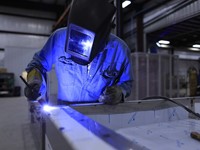Massage Therapy for Physically Demanding Jobs
BlogImage
Any type of job can cause a physical strain, but there are some jobs that are more physically demanding than others. From health professionals who are on their feet all day, to manual labourers, to factory workers that engage in many repetitive movements, there are a wide range of careers that can be considered physically demanding. Each of these careers poses unique strains on the body depending on their requirements. Work related musculoskeletal injuries can impact someone’s ability to continue working. These injuries can also have a major impact on overall physical function and quality of life. Massage therapy is a great option to help people with physically demanding jobs to keep moving, keep working, and keep enjoying their regular activities as much as possible.
Work-related pain in the arm, neck or shoulder because of repetitive movements or overuse is one of the most common causes or work related injury. Massage therapy, especially when combined with other interventions that can be recommended by an RMT such as ergonomic adjustments or exercises, can be effective in helping people with work-related upper limb injury manage their pain. Work-related musculoskeletal pain is particularly common among nurses, leading to significant time off work, and massage therapy is a great option for nurses to manage that pain. Massage therapy can help all individuals working in jobs at greater risk of musculoskeletal pain find some relief.
Common risk factors for work-related musculoskeletal disorders include awkward postures, prolonged static work, repetitive movements, forceful exertions and vibration and these conditions are more common in some jobs than in others. For example, more than half of truck drivers experience regular back pain, and more than half of factory workers experience musculoskeletal pain, most commonly low-back pain. Massage therapy is a great option to help people with low back pain reduce the frequency and severity of their pain and improve their range of motion.
Not all demanding jobs are physically demanding. Emergency medical services (EMS) workers experience significant levels of occupational stress, which often leads to physical pain and increased anxiety. Massage therapy is an effective way to help EMS workers reduce their occupational stress, which will also reduce the physical symptoms of that stress. Doctors, nurses and other health care workers often experience occupational stress which can lead to burnout, and massage therapy is a great option to reduce that stress and keep health care workers at work, doing what they love.
Musculoskeletal disorders are a common reason for people to miss work, especially in more physically demanding jobs. Jobs that are mentally or emotionally demanding can also lead to days of missed work. Massage therapy can help people relieve their work-related stress and reduce their work-related pain which can keep them thriving in the careers they love for longer.
References
Andrusaitis SF, Oliveira RP, Barros Filho TE. Study of the prevalence and risk factors for low back pain in truck drivers in the state of São Paulo, Brazil. Clinics (Sao Paulo). 2006 Dec;61(6):503-10.
Borges TP, Greve JM, Monteiro AP, da Silva RE, Giovani AM, da Silva MJ. Massage application for occupational low back pain in nursing staff. Rev Lat Am Enfermagem. 2012 May-Jun;20(3):511-9.
Hossain, M. D., Aftab, A., Al Imam, M. H., Mahmud, I., Chowdhury, I. A., Kabir, R. I., & Sarker, M. (2018). Prevalence of work related musculoskeletal disorders (WMSDs) and ergonomic risk assessment among readymade garment workers of Bangladesh: A cross sectional study. PloS one, 13(7), e0200122.
Kumar, S., Beaton, K., & Hughes, T. (2013). The effectiveness of massage therapy for the treatment of nonspecific low back pain: a systematic review of systematic reviews. International journal of general medicine, 6, 733–741
Mahdizadeh, M., Jaberi, A. A., & Bonabi, T. N. (2019). Massage Therapy in Management of Occupational Stress in Emergency Medical Services Staffs: a Randomized Controlled Trial. International journal of therapeutic massage & bodywork, 12(1), 16–22.
Miake-Lye, I. M., Mak, S., Lee, J., Luger, T., Taylor, S. L., Shanman, R., Beroes-Severin, J. M., & Shekelle, P. G. (2019). Massage for Pain: An Evidence Map. Journal of alternative and complementary medicine (New York, N.Y.), 25(5), 475–502.
Verhagen, A. P., Bierma-Zeinstra, S. M., Burdorf, A., Stynes, S. M., de Vet, H. C., & Koes, B. W. (2013). Conservative interventions for treating work-related complaints of the arm, neck or shoulder in adults. The Cochrane database of systematic reviews, 2013(12), CD008742.
Udom, C., Janwantanakul, P., & Kanlayanaphotporn, R. (2016). The prevalence of low back pain and its associated factors in Thai rubber farmers. Journal of occupational health, 58(6), 534–542.
Wang, F. J., Jin, X., Nazakat, M., Dong, Y. D., Wang, S. J., Zhang, Z. B., Yu, S. F., Yang, L. Y., & He, L. H. (2020). Beijing da xue xue bao. Yi xue ban = Journal of Peking University. Health sciences, 52(3), 535–540.
William G. Elder, PhD, Niki Munk, PhD, LMT, Margaret M. Love, PhD, Geza G. Bruckner, PhD, Kathryn E. Stewart, BS, LMT, Kevin Pearce, MD, MPH, Real-World Massage Therapy Produces Meaningful Effectiveness Signal for Primary Care Patients with Chronic Low Back Pain: Results of a Repeated Measures Cohort Study, Pain Medicine, Volume 18, Issue 7, July 2017, Pages 1394–1405
Zhang, X. J., Song, Y., Jiang, T., Ding, N., & Shi, T. Y. (2020). Interventions to reduce burnout of physicians and nurses: An overview of systematic reviews and meta-analyses. Medicine, 99(26), e20992.


